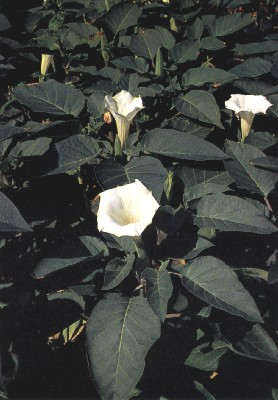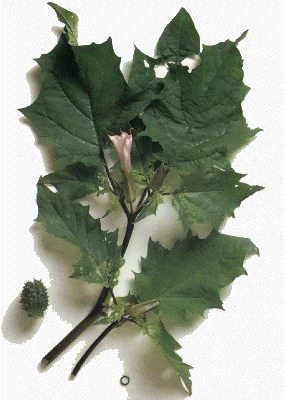
Michael's Hands
Datura
| By: Michael Manion | Viewed: 1/4/2026 |
Topics/Keywords: #Herbs #Datura | Page Views: 6064 |
| All about Datura. | |||
About The Plant

This plant is formally called Solanaceae Datura stramonium. Solanaceae is the order to which this herb belongs. It is Latin for nightshade. Stramonium is probably derived from the Greek for Mad-apple. The name Datura, its generic name, is from the Hindu Dhatura, which was derived from the Sanskrit name D'hastura. This herb is also known as Jimson Weed, Jamestown Weed, Thorn Apple, Mad Apple, Sacred Datura, Locoweed, Indian Apple, Stinkweed, Devil's Apple, Devil's Trumpet, Verba del Diablo, or Apple of Peru. The native peoples of America called this plant by various names. To the Kawaiisu people it was known as Moopi. To the Paiute people Mam-op-weep was how you addressed this plant. The Shoshoni called it Mui-ppeh.
The Datura plant was, at one time, a staple of witchcraft. Practitioners of The Craft would inhale the fumes and use it in their incantations. When ingested, it gave them a feeling of flying, which seems in keeping with the nature of one of the high holy days of some who celebrate October's "All Hallows Eve" (better known as Halloween).
It is thought by many that this plant was native to India, where it was used in ancient times by unsavory types to incapacitate those they wished to take advantage of. However, it seems that it may have been used medicinally long before that. In any case, it was from India that this weed was introduced to Europe.
During the times of ancient Egypt, the Nubians utilized this plant for many types of chest aliments. Unfortunately, their methods are not fully known today.
The ancient Greeks, during the times of the Delphi priests, claimed to become inspired by smoking the leaves of the Datura plant. Perhaps they did; but Datura's influence was apparently not effective enough; Delphi is no longer a useful oracle.
According to legend, around 70 BCE, Mark Anthony ate of this weed and became remarkably detached on the mind level and seem to go mad. The effect seemed to last for some time.
In much more recent history, one account from the United States is reported from 1676 in Jamestown, Virginia, where a British troop was detached to quiet a riot. While on their way to this situation, the soldiers happened to snack on some of the Datura plant. Those that did so, entered running through the town, crazed, and had to be tended to for about twelve days. We should note that, after this account, one of the familiar names given this plant was Jamestown Weed later changed or shortened to Jimson Weed.
In the Americas, the natives of various tribes used Datura as an hallucinogenic in order to induce visions and commune with the spirits. Native peoples of the Southwest and Mexico still use Datura for purposes of divination in healing rituals. These rituals and uses were reintroduced to American culture in the 1960s as mentioned in Carlos Castaneda's book The Teachings of Don Juan: Ayaqui Way of Knowledge. Within some of the Paiute Tribes of the Southwest, Datura was utilized. A cult called Toloache arose in which young adolescent girls and boys at puberty were given a boiled mash containing the Datura root combined with tobacco and lime. The cult's view was that, if the adolescent lived, he or she was meant to!
Datura grows all over the world. It grows with particular profusion in the southwestern portion of the United States.

How To Identify This Plant
The Datura plant is a bitter or foul, rank smelling, annual type plant. This is probably where it received its name as Stinkweed. The leaves are large and limber, ranging from lighter to mostly dark green.
The leaves of the Datura plant are oval in shape, with pointed incurvings. They alternate on the branch. The leaves that originate on the top part of the plant are darker than those on the bottom of the plant. They may grow anywhere from 4 to 6 inches long. They emit a sweet smelling odor when they are bruised or torn. This odor diminishes as the leaf dries.
The stout stems of this plant can be tough; they stand erect with the base area woody, yet fibrous and hard. Their color can range from dark brownish green to light green. They seem to branch in a fork-like manner.
The roots are very large and thick, white and fibrous. They seem to enjoy a moist, yet drained, soil.
The Datura flower appears as a 3 to 6 inch long, singular trumpet, from the leaf axils of the plant. They resemble enormous, brilliant, morning glories. This is why, in the 1960s, I used to call them morning glory bushes. Their color can range from slightly bluish to vibrant white. Datura flowers from May until late August in most environments.
The fruit is a four-capsulated pod. It starts out green and is spiny and rounded. As it dries, it turns brown and dark tan, and brittle. When ripe, these pods open from the top; each pod is possessed of many rough dark brown or black seeds.
The whole plant can grow from 3 feet in diameter and height. It can grow up to 6 feet in both when it is in rich soil. It usually is found in clusters, depending upon where the seeds land.
Medicinal Properties
This plant is widely grown for its medical properties. It is used in extremely small doses. It it not recommended to use this outside of well established organizations or groups which harvest it for medical purposes due to its very toxic nature. The active principles are extracted from the plant under parasitical supervision. Doses are carefully controlled for each with a different dose for each ailment.
Datura contains atropine, hyoscyamine and a trace of scopolamine which is also known as hyoscine. These are all toxic chemical components. Its medical properties influence brain transmitters that can effect involuntary muscles, the pressure and rate of the heart and brain itself. Symptoms of poisoning by this plant are an increase in heart pressure and rate and abnormal rhythm. If you note that you or someone you know has ingested any part of this plant watch for signs of dimness of sight, dilation of the pupils, giddiness and delirium. The seeds are the most poisonous.
This weed has been known to be used to check secretions of the body, stimulate circulation in those people with very low circulation, stimulate breathing during asthma attacks , cure dyspepsia, and overcome muscle spasms.
External applications of Datura have been used for hemorrhoids, skin eruptions such as boils or other pimple producing conditions, wounds and painful joint and muscle conditions. Be very careful as even external applications can be very toxic. Never take Datura as is, internally in any form. It is not only toxic it is hallucinogenic and very poisonous. small amounts of this plant can kill children. One antidote for poisoning by a ( Dr. Goodinough), is said to be 1/3 teaspoon of tannin dissolved in water, and followed with a strong mustard water. This will produce vomiting. Apply cold to a persons head and heat to their feet. Also have them drink strong coffee. Give these as needed.
Other Uses For Datura
When you apply parts of this plant in very small amounts locally in an ointment, plaster or fomentation it can help to alleviate the pain of muscular rheumatism, neuralgia, fistula, abscesses or pains due to hemorrhoid.
An ointment can be made from pork fat or lard and 1/4 to 1 grain per part of solid extract. Heat the combination very slowly and cool before applying. This can be useful in treating hemorrhoids. It is also applicable for boils, cuts burns and scaldings. Caution is to be heeded when making your own plasters or fomentations make sure to consult a professional before using.
The flower of the Datura plant has been know to be used as a poultice. These were used as a painkiller in treating various wounds
A juice can be pressed from the plant and made into an extract with doses of 1/2 a grain (32 mg.) up to a dram (1.7 g.). This would need to be taken within a period of 24 hours to assist in the relief of convulsions and possibly epilepsy.
When you dry and powder the leaves of the Datura plant, a dose of 1/10 of a grain (6.5 mg.) to 5 grains (325 mg.), can be useful in the treatment of asthmatic spasms. It can be added to other medicinal powders. It can be combined with Tobacco and smoked or inhaled to relieve asthma. Equal parts of Mullein leaves and Datura smoked, causes temporary relaxing of chest muscles, a drying up of the over active mucous membranes and numbing of the bronchial nerves. One remedy that early Pioneers of the American southwest used as "Asthma Powder", was to inhale the smoke from the igniting of equal part of saltpeter (potassium nitrate) and Datura leaves.
For these early settlers a cup of chopped up Datura plant and a tablespoon of Cayenne Pepper was steeped in a quart of rubbing alcohol for a week and made a good analgesic liniment.
©1998-2026 Michael Manion
All Rights Reserved
